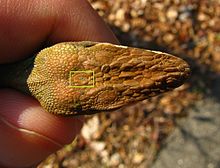Parting eye

The parietal eye, also called the parietal eye or organ, is an upwardly directed, central third eye on the parietal bone ( os parietale ) of the skull , which in original vertebrates serves as a light sense organ for the perception of differences in brightness.
description
Like an ordinary pair of eyes, the vertex eye consists of a lens , retina and optic nerve , only the iris is missing. The organ is not exposed, but is hidden under the skin. The connection to the diencephalon is established via the parietal hole, which is located between the paired bones of the parietal bone.
The vertebrate eye of the Paleozoic Era, the placodermi (armored fish), the jawless and the tetrapod amphibians and reptiles in general developed. In ( recent ) animals living today , for example some types of iguana , the parietal eye can be seen in the form of a translucent scale in the middle of the head, which lets light into the inside of the skull. The eye is also still present in the New Zealand bridge lizard ( Sphenodon punctatus ), a living fossil , and the primeval lampreys . Behavioral observations indicate that the parietal eye is at least used to distinguish between light and dark, possibly also to recognize movement and thus to protect against predators such as birds of prey.
Evolution of the vertex eye
Originally, the parietal eye seems to have also been formed in pairs according to the paired system of the parietal bone; its two parts were later transformed independently of each other into homologous light-sensing organs (parietal organ and pineal organ). Where the left eye moved forward, it became the Parietalorgan (Parapinealorgan) or-eye of the higher vertebrates such as lizards and tuatara , but where it wandered back was originally right eye to the pineal gland or the-eye Frogs and lampreys. The other eye in each case can exceptionally remain with a loss of function, as in the case of the sea lamprey , or, as in higher vertebrates, with a change of function it can be transformed into a pineal gland, which is often still sensitive to light . By releasing the hormone melatonin, this ensures the control of circadian rhythms of day and night activity and regulates body temperature ( thermoregulation ) and food intake , especially in reptiles and some birds . In terms of developmental history , the pineal gland is thus the oldest organ that controls the daily rhythm .
See also
literature
- Alfred Sherwood Romer , Thomas S. Parsons: Comparative Anatomy of the Vertebrates. 5th, revised and expanded edition. Paul Parey, Hamburg et al. 1983, ISBN 3-490-21718-7 .
